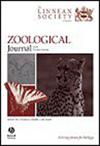Reassessment of ‘Gyposaurus’ sinensis Young, 1941 (Dinosauria: Sauropodomorpha) from the Early Jurassic Lufeng Basin, Yunnan Province, China
IF 3
2区 生物学
Q1 ZOOLOGY
引用次数: 0
Abstract
The Early Jurassic Lufeng Formation of Yunnan Province, southwestern China, has yielded a rich assemblage of early-branching sauropodomorphs. The syntype series of ‘Gyposaurus’ sinensis Young, 1941, represented by two skeletons from the Shawan Member of this formation, was the second-earliest named taxon after Lufengosaurus huenei Young, 1941. However, its taxonomic status has been debated ever since, owing to the invalidity of the genus ‘Gyposaurus’. Here, we provide a detailed redescription of the remaining syntype specimens of ‘Gyposaurus’ sinensis, including V26 and V27, which comprise almost complete postcranial skeletons. Both the unfused vertebrae and the osteohistology of the syntype specimens suggest that they are immature individuals. The morphology of the skeletons, especially that of the scapula, humerus, ilium, and femur of ‘Gyposaurus’ sinensis, is more similar to that of Lufengosaurus huenei than to that of other non-sauropodan sauropodomorphs. A phylogenetic analysis, in which ‘Gyposaurus’ sinensis and Lufengosaurus huenei were included as separate terminal taxa, recovered ‘Gyposaurus’ sinensis as part of a polytomy with Lufengosaurus huenei and Glacialisaurus, also indicating a close relationship between these taxa. Therefore, we suggest that ‘Gyposaurus’ sinensis is probably referable to a junior synonym of Lufengosaurus huenei.重新评估中国云南省禄丰盆地早侏罗世的'Gyposaurus' sinensis Young, 1941 (Dinosauria: Sauropodomorpha)
中国西南部云南省的早侏罗世禄丰地层出土了丰富的早分支剑龙类群。中华侏罗纪龙(Gyposaurus)Young,1941年,是继禄丰龙(Lufengosaurus huenei Young,1941年)之后第二早被命名的类群。然而,由于 "Gyposaurus "属的无效性,它的分类地位一直存在争议。在此,我们重新详细描述了 "Gyposaurus "中华龙的剩余同型标本,包括V26和V27,它们包括几乎完整的颅后骨骼。这些同型标本未融合的脊椎骨和骨组织学都表明它们是未成熟个体。这些骨骼的形态,尤其是 "Gyposaurus "中华龙的肩胛骨、肱骨、髂骨和股骨的形态,与禄丰龙(Lufengosaurus huenei)相比,与其他非驴脚类的类人猿更为相似。在系统发育分析中,我们将 "Gyposaurus "中华龙和禄丰龙作为独立的末端类群,结果发现 "Gyposaurus "中华龙与禄丰龙和冰川龙组成了一个多面体,这也表明这些类群之间存在着密切的关系。因此,我们认为 "Gyposaurus "中华龙可能是禄丰龙的一个小异名。
本文章由计算机程序翻译,如有差异,请以英文原文为准。
求助全文
约1分钟内获得全文
求助全文
来源期刊
CiteScore
6.50
自引率
10.70%
发文量
116
审稿时长
6-12 weeks
期刊介绍:
The Zoological Journal of the Linnean Society publishes papers on systematic and evolutionary zoology and comparative, functional and other studies where relevant to these areas. Studies of extinct as well as living animals are included. Reviews are also published; these may be invited by the Editorial Board, but uninvited reviews may also be considered. The Zoological Journal also has a wide circulation amongst zoologists and although narrowly specialized papers are not excluded, potential authors should bear that readership in mind.

 求助内容:
求助内容: 应助结果提醒方式:
应助结果提醒方式:


